Cataloging Your Collections
by Bob Brooke
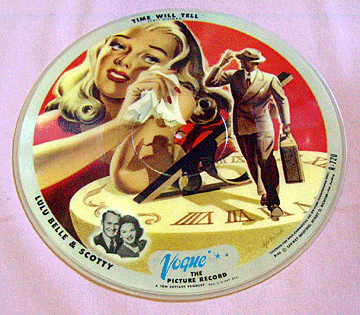 What
began as you buying an item for a few dollars at a flea market here and
there can quickly grow into an investment of several hundred, even
several thousand dollars. And don’t forget all the time you spent
researching and hunting for pieces for your collection. It’s important
to keep your collection safe, but to do that, you need to catalog it. What
began as you buying an item for a few dollars at a flea market here and
there can quickly grow into an investment of several hundred, even
several thousand dollars. And don’t forget all the time you spent
researching and hunting for pieces for your collection. It’s important
to keep your collection safe, but to do that, you need to catalog it.
There are three ways to catalogue your collections. All of them are
rather simple. The first uses standard 3 x 5 or 5 x 8-inch cards and a
notebook, or logbook. Or if you prefer, you can use a three-ring binder
with dividers to keep all your information under one cover. In either
case, you won’t need any special materials since you can purchase all of
them at any office-supply store.
The third way is to create a computer database. You can begin by using
the cards you prepared above, then transferring the information to a
database, such as Microsoft Access, later.
The All-Important Catalog Number
The first step is to give each item a catalog number. This should appear
on the object, in your logbook, and on every receipt, canceled check,
photograph, or card that relates to it. This number is the essential
link between your records and the item.
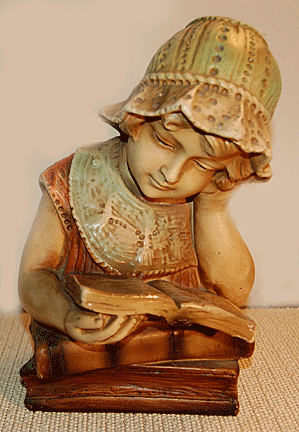 Number
the objects in your collection in the order in which you acquired them.
Although you can use a simple number, a three-part number is more useful
because it includes the year you acquired the object and the source.
Individual items you purchased at the same time from the same source
will each have this number. Number
the objects in your collection in the order in which you acquired them.
Although you can use a simple number, a three-part number is more useful
because it includes the year you acquired the object and the source.
Individual items you purchased at the same time from the same source
will each have this number.
It’s a good idea to record the numbers consecutively in your logbook as
soon as you assign them. Include in the entry basic information about
the source, a brief description of the object, and the price you paid
for it. You can use that information, along with the receipt or your
canceled check, to document a claim if a part or all of your collection
should be damaged or destroyed. Store your log in a safe place and
update it regularly.
Labeling the Items in Your Collection
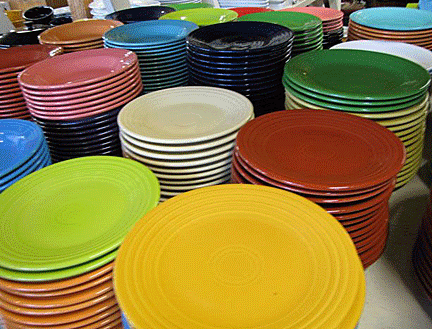 After
you’ve created a numbering system and assigned numbers to the items in
your collection, you’ll need to attach them to the objects. Whichever
technique you use depends on the object’s surface. Use removable labels
that are durable and long-lasting in case you wish to sell an item from
your collection. Choose a place for the label on the bottom or back of
objects, being careful not to obliterate any trademarks, serial
numbers,, patent dates, or maker's signatures. Use a thin pointed
Sharpie marker to print the numbers on the labels. After
you’ve created a numbering system and assigned numbers to the items in
your collection, you’ll need to attach them to the objects. Whichever
technique you use depends on the object’s surface. Use removable labels
that are durable and long-lasting in case you wish to sell an item from
your collection. Choose a place for the label on the bottom or back of
objects, being careful not to obliterate any trademarks, serial
numbers,, patent dates, or maker's signatures. Use a thin pointed
Sharpie marker to print the numbers on the labels.
If you have an ephemera (paper) collection, you should use a soft pencil
to write the numbers on the labels. Apply the label in an inconspicuous
place, preferably on the back, always keeping in mind that you may have
to remove it. Place the label on a sturdy portion of the paper, not so
close to the edge that the paper will tear if you have to erase the
number.
For rugs, quilts, samplers, wall hangings, and clothing, use small
fabric labels numbered with a laundry or fine ballpoint pen. Always test
the pen first on a piece of scrap label to make sure that the ink
doesn’t bleed or smear. Attach the label to the fabric with only one or
two stitches at each corner so that the label can easily be removed
without damaging the fabric.
Creating an Inventory of Your Collection
Now that you’ve numbered all of your items, you need to create a
complete inventory of them. This will help you to remember what you paid
for each. It’s a good idea to measure each item, especially furniture
and record the dimensions. It will be difficult to remember just what
size your things were if someone steals them or they’re destroyed in a
fire or flood.
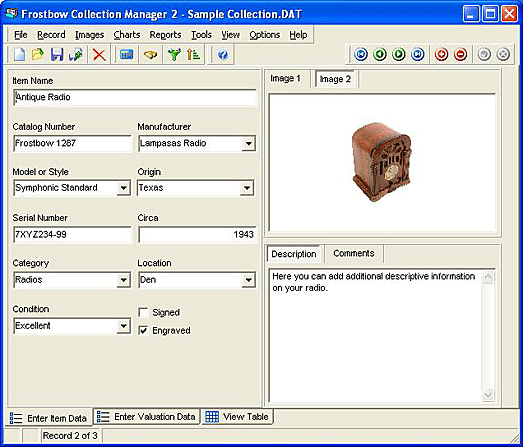
Your inventory should include the object’s name, maker, price paid,
expenses such as shipping or restoration, identifying marks, and current
value. The more information you have about a piece the more likely it
will be recovered, or at least covered by insurance.
It’s also a good idea to take a photo of each item or groups of items in
your collection. While it’s desirable to take a good clear photo of each
piece in your collection, you may want to group like items for
efficiency but make sure each item is clearly visible.
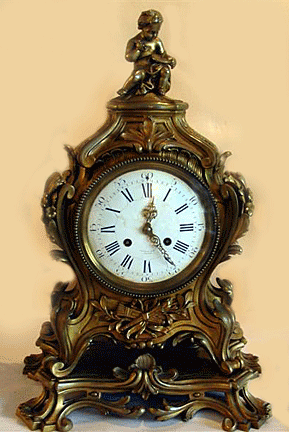 Using
a digital camera is an inexpensive way to visually record your
collection. You don’t need an expensive camera. Your smart phone will do
fine. If your collection consists of small items like jewelry or
thimbles, then a digital camera with macro capability is necessary. A
compact digital camera is probably your best choice since it comes a
lens with macro capability. Using
a digital camera is an inexpensive way to visually record your
collection. You don’t need an expensive camera. Your smart phone will do
fine. If your collection consists of small items like jewelry or
thimbles, then a digital camera with macro capability is necessary. A
compact digital camera is probably your best choice since it comes a
lens with macro capability.
If you’re working with small objects, you might want to also consider
buying or making a lightbox—a box with white paper on three sides and
bottom—in which you can photograph them. Save the originals as is, but
make copies of all the photos before editing and rename them using the
catalog number you’ve assigned to that object.
If your items are stolen these photos will be invaluable to the police
in identifying them. They’ll also prove to the insurance company that
you had the items, and they may help you to retrieve your antiques. Some
antique periodicals run notices about stolen antiques. A good photo of
your missing piece in such a publication will make it possible for
dealers and collectors to recognize your treasured antique when someone
tries to sell it.
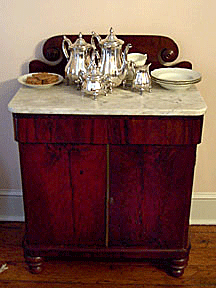 The
third method of documenting your collection is to make a video of it.
Record your entire collection using either a digital video recorder, a
camcorder, or your smart phone. This will help prove to insurance
companies just what you had. Filming one set of silver flatware, for
example, saying that you have a service for eight isn’t enough. You must
show all eight sets at the same time. Some insurance companies will
insist that you only had one set to begin with. Don't give your
insurance company the chance to short change you. Also remember that you
must insure antiques as antiques, otherwise it will list your $2,000
American Empire marble-top washstand as a used cabinet, and you’ll
receive very little for it. Insurance companies are very good at
ignoring the fact that antiques are valuable. It’s extremely important
to keep your records somewhere other than your own home. The records of
your collection won’t be of much use if they’re stolen or destroyed
along with your collection. One simple way to prevent this from
happening is to have a friend keep your collection records for you. You
can also put your catalog file and photos on a CD or DVD, along with a
printout of your catalog, and place them in a safe deposit box. The
third method of documenting your collection is to make a video of it.
Record your entire collection using either a digital video recorder, a
camcorder, or your smart phone. This will help prove to insurance
companies just what you had. Filming one set of silver flatware, for
example, saying that you have a service for eight isn’t enough. You must
show all eight sets at the same time. Some insurance companies will
insist that you only had one set to begin with. Don't give your
insurance company the chance to short change you. Also remember that you
must insure antiques as antiques, otherwise it will list your $2,000
American Empire marble-top washstand as a used cabinet, and you’ll
receive very little for it. Insurance companies are very good at
ignoring the fact that antiques are valuable. It’s extremely important
to keep your records somewhere other than your own home. The records of
your collection won’t be of much use if they’re stolen or destroyed
along with your collection. One simple way to prevent this from
happening is to have a friend keep your collection records for you. You
can also put your catalog file and photos on a CD or DVD, along with a
printout of your catalog, and place them in a safe deposit box.
Most growing collections represent substantial investments of time and
effort as well as money. Besides its obvious uses for insurance claims,
a carefully kept catalogue is valuable to those who may buy or inherit
your collection. Cataloguing is also a way of becoming intimately
acquainted with all the objects in your collection, identifying the
collection's strengths and weaknesses, and taking the time to enjoy it
thoroughly.
To read
more of my articles, please
visit
my Web site.
<
Back to Caring for Your
Collections Archives
Next Article >
|
